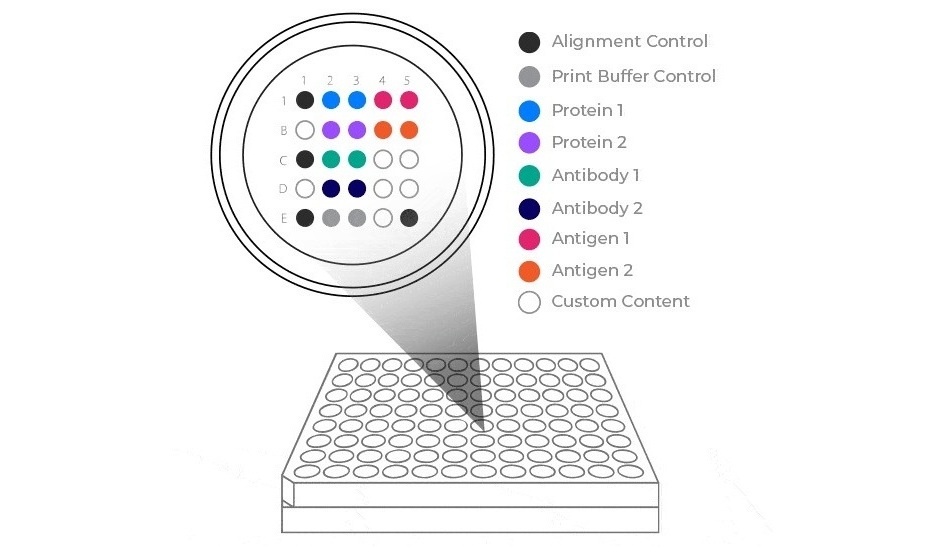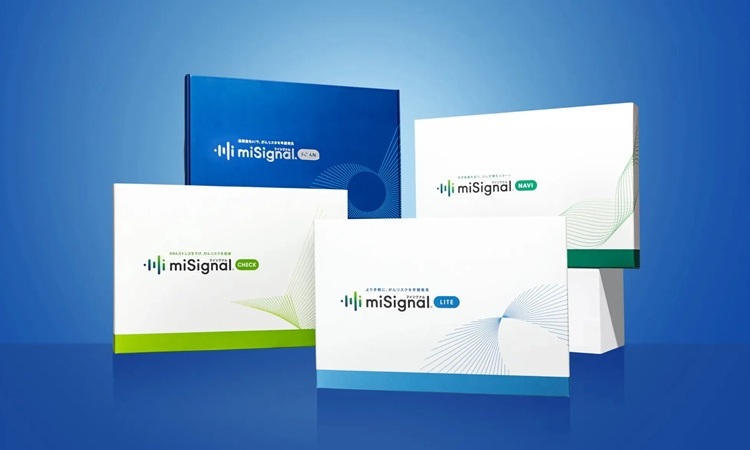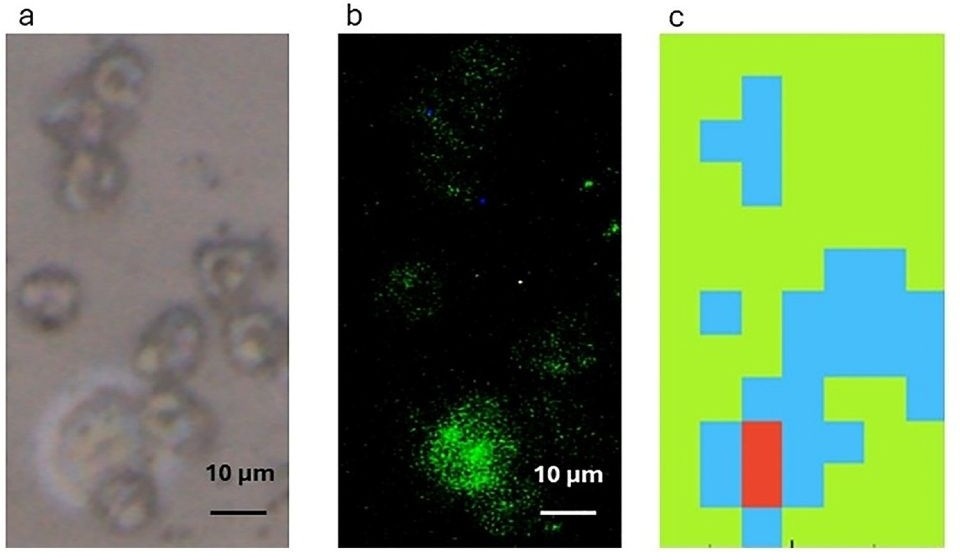POC Test Based on Quantum Dots Detects Antibody Responses
|
By LabMedica International staff writers Posted on 31 Oct 2019 |

Image: The Holomics Reader HRDR-300 mobile device was used to measure fluorescent intensity of the quantum dots complex after lateral migration of patient serum (Photo courtesy of Medical College of Georgia).
Point-of-care (POC) assays, which can be performed at or near the site of care with a rapid turnaround time, are pivotal to transforming global disease control efforts, particularly in resource-constrained settings where access to laboratory facilities is limited.
Cysticercosis is an infection caused by the larval form of the pork tapeworm Taenia solium. When larval cysts form in the human brain known as neurocysticercosis (NCC), they can result in seizures and other neurologic disorders. NCC affects those living in endemic and non-endemic countries, with an estimated more than 18,000 hospitalizations in the USA between 2003 and 2012.
Medical scientists at the Medical College of Georgia (Athens, GA, USA) and their international colleagues examined 112 positive human sera from patients with neurocysticercosis (NCC) including samples from 18 patients with single viable cyst, 71 patients with two or more viable cysts, and 23 patients with subarachnoid (racemose) cysts. Definitive diagnosis of the subject was established by computed-tomography and/or magnetic resonance imaging.
To test the specificity of the assay, the team evaluated a panel of serum samples obtained from 24 patients with other infections and 128 serum samples from persons in the USA and Egypt who had not traveled outside their country, and therefore were presumed negative for cysticercosis. The scientists developed a novel and portable fluorescent sensor that integrates a lateral flow assay with a quantum dot (Qdots) label and a mobile phone reader for detection of specific antibodies in human serum. They evaluated the utility of this assay to test for antibodies to the Taenia solium rT24H antigen.
The team read the lateral flow assay after 30 minutes, using the Holomics Reader HRDR-30. The investigators reported that the assay specificity in the negative panel was 99% (95%–100%) while assay sensitivity was 89% (79%–95%) in NCC patients with two or more viable cysts. The assay has performance characteristics similar to those of traditional platforms for the detection of NCC and shows promise as a mobile phone reader-based point-of-care test for antibody detection. The study was published on October 7, 2019, in the journal PLOS Neglected Tropical Diseases.
Related Links:
Medical College of Georgia
Cysticercosis is an infection caused by the larval form of the pork tapeworm Taenia solium. When larval cysts form in the human brain known as neurocysticercosis (NCC), they can result in seizures and other neurologic disorders. NCC affects those living in endemic and non-endemic countries, with an estimated more than 18,000 hospitalizations in the USA between 2003 and 2012.
Medical scientists at the Medical College of Georgia (Athens, GA, USA) and their international colleagues examined 112 positive human sera from patients with neurocysticercosis (NCC) including samples from 18 patients with single viable cyst, 71 patients with two or more viable cysts, and 23 patients with subarachnoid (racemose) cysts. Definitive diagnosis of the subject was established by computed-tomography and/or magnetic resonance imaging.
To test the specificity of the assay, the team evaluated a panel of serum samples obtained from 24 patients with other infections and 128 serum samples from persons in the USA and Egypt who had not traveled outside their country, and therefore were presumed negative for cysticercosis. The scientists developed a novel and portable fluorescent sensor that integrates a lateral flow assay with a quantum dot (Qdots) label and a mobile phone reader for detection of specific antibodies in human serum. They evaluated the utility of this assay to test for antibodies to the Taenia solium rT24H antigen.
The team read the lateral flow assay after 30 minutes, using the Holomics Reader HRDR-30. The investigators reported that the assay specificity in the negative panel was 99% (95%–100%) while assay sensitivity was 89% (79%–95%) in NCC patients with two or more viable cysts. The assay has performance characteristics similar to those of traditional platforms for the detection of NCC and shows promise as a mobile phone reader-based point-of-care test for antibody detection. The study was published on October 7, 2019, in the journal PLOS Neglected Tropical Diseases.
Related Links:
Medical College of Georgia
Latest Microbiology News
- New UTI Diagnosis Method Delivers Antibiotic Resistance Results 24 Hours Earlier
- Breakthroughs in Microbial Analysis to Enhance Disease Prediction
- Blood-Based Diagnostic Method Could Identify Pediatric LRTIs
- Rapid Diagnostic Test Matches Gold Standard for Sepsis Detection
- Rapid POC Tuberculosis Test Provides Results Within 15 Minutes
- Rapid Assay Identifies Bloodstream Infection Pathogens Directly from Patient Samples
- Blood-Based Molecular Signatures to Enable Rapid EPTB Diagnosis
- 15-Minute Blood Test Diagnoses Life-Threatening Infections in Children
- High-Throughput Enteric Panels Detect Multiple GI Bacterial Infections from Single Stool Swab Sample
- Fast Noninvasive Bedside Test Uses Sugar Fingerprint to Detect Fungal Infections
- Rapid Sepsis Diagnostic Device to Enable Personalized Critical Care for ICU Patients
- Microfluidic Platform Assesses Neutrophil Function in Sepsis Patients
- New Diagnostic Method Confirms Sepsis Infections Earlier
- New Markers Could Predict Risk of Severe Chlamydia Infection
- Portable Spectroscopy Rapidly and Noninvasively Detects Bacterial Species in Vaginal Fluid
- CRISPR-Based Saliva Test Detects Tuberculosis Directly from Sputum
Channels
Clinical Chemistry
view channel
Blood Test Could Predict and Identify Early Relapses in Myeloma Patients
Multiple myeloma is an incurable cancer of the bone marrow, and while many patients now live for more than a decade after diagnosis, a significant proportion relapse much earlier with poor outcomes.... Read more
Compact Raman Imaging System Detects Subtle Tumor Signals
Accurate cancer diagnosis often depends on labor-intensive tissue staining and expert pathological review, which can delay results and limit access to rapid screening. These conventional methods also make... Read moreMolecular Diagnostics
view channel
Multiplex Antibody Assay Could Transform Hepatitis B Immunity Testing
Hepatitis B remains a major global health challenge, yet immunity testing has historically been constrained by cost, operational complexity, and single-analyte approaches. Now, a multiplex antibody assay... Read more
Genetic Testing Improves Comprehensive Risk-Based Screening for Breast Cancer
Breast cancer screening has long relied on age-based guidelines, assuming similar risk across all women despite clear evidence that individual risk varies widely. This one-size-fits-all approach can lead... Read more
Urine Test Could Reveal Real Age and Life Span
Chronological age does not always reflect how quickly the body is aging, as biological age is shaped by genetics, stress, sleep, nutrition, and lifestyle factors such as smoking. A higher biological age... Read more
Genomic Test Identifies African Americans at Risk for Early Prostate Cancer Recurrence
Prostate cancer is one of the most commonly diagnosed cancers in men and a leading cause of cancer-related death, particularly in the United States. African American men face a disproportionately higher... Read moreHematology
view channel
MRD Tests Could Predict Survival in Leukemia Patients
Acute myeloid leukemia is an aggressive blood cancer that disrupts normal blood cell production and often relapses even after intensive treatment. Clinicians currently lack early, reliable markers to predict... Read more
Platelet Activity Blood Test in Middle Age Could Identify Early Alzheimer’s Risk
Early detection of Alzheimer’s disease remains one of the biggest unmet needs in neurology, particularly because the biological changes underlying the disorder begin decades before memory symptoms appear.... Read more
Microvesicles Measurement Could Detect Vascular Injury in Sickle Cell Disease Patients
Assessing disease severity in sickle cell disease (SCD) remains challenging, especially when trying to predict hemolysis, vascular injury, and risk of complications such as vaso-occlusive crises.... Read more
ADLM’s New Coagulation Testing Guidance to Improve Care for Patients on Blood Thinners
Direct oral anticoagulants (DOACs) are one of the most common types of blood thinners. Patients take them to prevent a host of complications that could arise from blood clotting, including stroke, deep... Read moreMicrobiology
view channel
New UTI Diagnosis Method Delivers Antibiotic Resistance Results 24 Hours Earlier
Urinary tract infections affect around 152 million people every year, making them one of the most common bacterial infections worldwide. In routine medical practice, diagnosis often relies on rapid urine... Read more
Breakthroughs in Microbial Analysis to Enhance Disease Prediction
Microorganisms shape human health, ecosystems, and the planet’s climate, yet identifying them and understanding how they are related remains a major scientific challenge. Even with modern DNA sequencing,... Read morePathology
view channel
Genetics and AI Improve Diagnosis of Aortic Stenosis
Aortic stenosis is a progressive narrowing of the aortic valve that restricts blood flow from the heart and can be fatal if left untreated. There are currently no medical therapies that can prevent or... Read more
AI Tool Simultaneously Identifies Genetic Mutations and Disease Type
Interpreting genetic test results remains a major challenge in modern medicine, particularly for rare and complex diseases. While existing tools can indicate whether a genetic mutation is harmful, they... Read more
Rapid Low-Cost Tests Can Prevent Child Deaths from Contaminated Medicinal Syrups
Medicinal syrups contaminated with toxic chemicals have caused the deaths of hundreds of children worldwide, exposing a critical gap in how these products are tested before reaching patients.... Read more
Tumor Signals in Saliva and Blood Enable Non-Invasive Monitoring of Head and Neck Cancer
Head and neck cancers are among the most aggressive malignancies worldwide, with nearly 900,000 new cases diagnosed each year. Monitoring these cancers for recurrence or relapse typically relies on tissue... Read moreTechnology
view channel
Pioneering Blood Test Detects Lung Cancer Using Infrared Imaging
Detecting cancer early and tracking how it responds to treatment remains a major challenge, particularly when cancer cells are present in extremely low numbers in the bloodstream. Circulating tumor cells... Read more
AI Predicts Colorectal Cancer Survival Using Clinical and Molecular Features
Colorectal cancer is one of the most common and deadly cancers worldwide, and accurately predicting patient survival remains a major clinical challenge. Traditional prognostic tools often rely on either... Read moreIndustry
view channel
BD and Penn Institute Collaborate to Advance Immunotherapy through Flow Cytometry
BD (Becton, Dickinson and Company, Franklin Lakes, NJ, USA) has entered into a strategic collaboration with the Institute for Immunology and Immune Health (I3H, Philadelphia, PA, USA) at the University... Read more


















